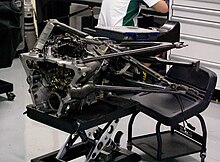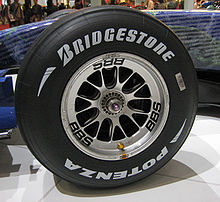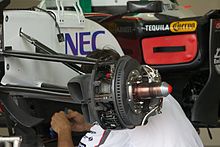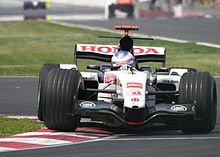A Formula One car is a single-seat, open cockpit, open-wheel racing car with substantial front and rear wings, and an engine positioned behind the driver, intended to be used in competition at Formula One racing events. The regulations governing the cars are unique to the championship. The Formula One regulations specify that cars must be constructed by the racing teams themselves, though the design and manufacture can be outsourced.
Engines
A Renault RS26 V8 engine, which powered the 2006 Renault R26
The BMW M12/13, a massively powerful 4-cylinder 1.5-litre turbo that powered the Brabham-BMW cars in the 1980s developed 1400 bhp power during qualifying.[citation needed]
The BRM H16 engine, tough but not successful was a 16-cylinder 64-valve engine that powered the BRM team
For a decade, F1 cars had run with 3.0-litre naturally aspirated engines with all teams settling on a V10 layout by the end of the period; however, development had led to these engines producing between 980 and 1,000 hp (730 and 750 kW),[5] and the cars reaching top speeds of 375 km/h (233 mph) (Jacques Villeneuve with Sauber-Ferrari) on the Monza circuit.[citation needed] Teams started to use exotic alloys in the late 1990s, leading to the FIA banning the use of exotic materials in engine construction, with only aluminium, titanium and iron alloys being allowed for the pistons, cylinders, connecting rods and crankshafts.[4] The FIA has continually enforced material and design restrictions to limit power. Even with the restrictions, the V10s in the 2005 season were reputed to develop 980 hp (730 kW), power levels not seen since the ban on turbo-charged engines in 1989.[5]
The lesser funded teams (the former Minardi team spends less than 50 million, while Ferrari spent hundreds of millions of euros a year developing their car) had the option of keeping the current V10 for another season, but with a rev limiter to keep them competitive with the most powerful V8 engines. The only team to take this option was the Toro Rosso team, which was the reformed and regrouped Minardi.
The engines consume around 450 l (15.9 ft3) of air per second.[6] Race fuel consumption rate is normally around 75 l/100 km travelled (3.1 US mpg, 3.8 imp mpg, 1.3 km/l).
All cars have the engine located between the driver and the rear axle. The engines are a stressed member in most cars, meaning that the engine is part of the structural support framework, being bolted to the cockpit at the front end, and transmission and rear suspension at the back end.
In the 2004 championship, engines were required to last a full race weekend. For the 2005 championship, they were required to last two full race weekends and if a team changes an engine between the two races, they incur a penalty of 10 grid positions. In 2007, this rule was altered slightly and an engine only had to last for Saturday and Sunday running. This was to promote Friday running. In the 2008 season, engines were required to last two full race weekends; the same regulation as the 2006 season. However, for the 2009 season, each driver is allowed to use a maximum of 8 engines over the season, meaning that a couple of engines have to last three race weekends. This method of limiting engine costs also increases the importance of tactics, since the teams have to choose which races to have a new or an already-used engine.
As of the 2014 season, all F1 cars have been equipped with turbocharged 1.6-litre V6 engines. Turbochargers had previously been banned since 1988. This change may give an improvement of up to 29% fuel efficiency.[7] One of the many reasons that Mercedes dominated the season early, was due to the placement of the turbocharger's compressor at one side of the engine, and the turbine at the other; both were then linked by a shaft travelling through the vee of the engine. The benefit is that air is not traveling through as much pipework, in turn reducing turbo lag and increases efficiency of the car. In addition, it means that the air moving through the compressor is much cooler as it is further away from the hot turbine section
Transmission
The gearbox with mounted rear suspension elements from the Lotus T127, Lotus Racing's car for the 2010 season.
A modern F1 clutch is a multi-plate carbon design with a diameter of less than 100 mm (3.9 in),[12] weighing less than 1 kg (2.2 lb) and handling around 720 hp (540 kW).[5] As of the 2009 race season, all teams are using seamless shift transmissions, which allow almost instantaneous changing of gears with minimum loss of drive. Shift times for Formula One cars are in the region of 0.05 seconds.[13] In order to keep costs low in Formula One, gearboxes must last five consecutive events and since 2015, gearbox ratios will be fixed for each season (for 2014 they could be changed only once). Changing a gearbox before the allowed time will .
cause a penalty of five places drop on the starting grid for the first event that the new gearbox is used.
Wings
Front and rear wings made their appearance in the late 1960s. Seen here in a 1969 Matra Cosworth MS80. By the end of the 1960s wings had become a standard feature in all Formula cars
A low downforce spec. front wing on the Renault R30
F1 car. Front wings heavily influence the cornering speed and handling
of a car, and are regularly changed depending on the downforce
requirements of a circuit.
The F1 cars for the 2009 season came under much questioning due to the design of the rear diffusers of the Williams, Toyota and the Brawn GP cars raced by Jenson Button and Rubens Barrichello, dubbed double diffusers. Appeals from many of the teams were heard by the FIA, which met in Paris, before the 2009 Chinese Grand Prix and the use of such diffusers was declared as legal. Brawn GP boss Ross Brawn claimed the double diffuser design as "an innovative approach of an existing idea". These were subsequently banned for the 2011 season. Another controversy of the 2010 and '11 seasons was the front wing of the Red Bull cars. Several teams protested claiming the wing was breaking regulations. Footage from high speed sections of circuits showed the Red Bull front wing bending on the outsides subsequently creating greater downforce. Test were held on the Red Bull front wing however the FIA could find no way that the wing was breaking any regulation.
Since the start of the 2011 season, cars have been allowed to run with an adjustable rear wing, more commonly known as DRS (drag reduction system), a system to combat the problem of turbulent air when overtaking. On the straights of a track, drivers can deploy DRS, which opens the rear wing, reduces the drag of the car, allowing it to move faster. As soon as the driver touches the brake, the rear wing shuts again. In free practice and qualifying, a driver may use it whenever he wishes to, but in the race, it can only be used if the driver is 1 second, or less, behind another driver at the DRS detection zone on the race track, at which point it can be activated in the activation zone until the driver brakes.
Ground effect
A rear diffuser on a 2009 Renault R29. Rear diffusers have been an important aerodynamic aid since late 1980s
A substantial amount of downforce is provided by using a rear diffuser which rises from the undertray at the rear axle to the actual rear of the bodywork. The limitations on ground effects, limited size of the wings (requiring use at high angles of attack to create sufficient downforce), and vortices created by open wheels lead to a high aerodynamic drag coefficient (about 1 according to Minardi's technical director Gabriele Tredozi;[18] compare with the average modern saloon car, which has a Cd value between 0.25 and 0.35), so that, despite the enormous power output of the engines, the top speed of these cars is less than that of World War II vintage Mercedes-Benz and Auto Union Silver Arrows racers. However, this drag is more than compensated for by the ability to corner at extremely high speed. The aerodynamics are adjusted for each track; with a low drag configuration for tracks where high speed is more important like Autodromo Nazionale Monza, and a high traction configuration for tracks where cornering is more important, like the Circuit de Monaco.
Steering wheel
A 2012 Lotus F1 wheel, with a complex array of dials, knobs, and buttons.
Fuel
The fuel used in F1 cars is fairly similar to ordinary petrol, albeit with a far more tightly controlled mix. Formula One fuel can only contain compounds that are found in commercial gasoline, in contrast to alcohol-based fuels used in American open-wheel racing. Blends are tuned for maximum performance in given weather conditions or different circuits. During the period when teams were limited to a specific volume of fuel during a race, exotic high-density fuel blends were used which were actually denser than water, since the energy content of a fuel depends on its mass density.To make sure that the teams and fuel suppliers are not violating the fuel regulations, the FIA requires Elf, Shell, Mobil, Petronas and the other fuel teams to submit a sample of the fuel they are providing for a race. At any time, FIA inspectors can request a sample from the fueling rig to compare the "fingerprint" of what is in the car during the race with what was submitted. The teams usually abide by this rule, but in 1997, Mika Häkkinen was stripped of his third-place finish at Spa-Francorchamps in Belgium after the FIA determined that his fuel was not the correct formula, as well as in 1976, both McLaren and Penske cars were forced to the rear of the Italian Grand Prix after the octane number of the mixture was found to be too high.
Tyres
Bridgestone Potenza F1 front tyre
Tyres can be no wider than 355 and 380 mm (14.0 and 15.0 in) at the rear, front tyre width reduced from 270 mm to 245 mm for the 2010 season. Unlike the fuel, the tyres bear only a superficial resemblance to a normal road tyre. Whereas a roadcar tyre has a useful life of up to 80,000 km (50,000 mi), a Formula One tyre does not even last the whole race distance (a little over 300 km (190 mi)); they are usually changed two or three times per race, depending on the track. This is the result of a drive to maximise the road-holding ability, leading to the use of very soft compounds (to ensure that the tyre surface conforms to the road surface as closely as possible).
Since the start of the 2007 season, F1 had a sole tyre supplier. From 2007 to 2010, this was Bridgestone, but 2011 saw the reintroduction of Pirelli into the sport, following the departure of Bridgestone. Seven compounds of F1 tyre exist; 5 are dry weather compounds (hard, medium, soft, super-soft and ultra soft) while 2 are wet compounds (intermediates for damp surfaces with no standing water and full wets for surfaces with standing water). Two of the dry weather compounds (generally a harder and softer compound) are brought to each race, plus both wet weather compounds. The harder tyre is more durable but gives less grip, and the softer tyre the opposite. In 2009, the slick tyres returned as a part of revisions to the rules for the 2009 season; slicks have no grooves and give up to 18% more contact with the track. In the Bridgestone years, a green band on the sidewall of the softer compound was painted to allow spectators to distinguish which tyre a driver is on. With Pirelli tyres, the colour of the text and the ring on the sidewall varies with the compounds. Generally, the two dry compounds brought to the track are separated by at least one specification. This was implemented by the FIA to create more noticeable difference between the compounds and hopefully add more excitement to the race when two drivers are on different strategies. The exceptions are the Monaco GP, Singapore Grand Prix and the Hungaroring, where soft and super-soft tyres are brought, because they are notably slow and twisty and require a lot of grip.
Brakes
Brake discs on the Mercedes MGP W02.
An average F1 car can decelerate from 100 to 0 km/h (62 to 0 mph) in about 15 meters (48 ft), compared with a 2009 BMW M3, which needs 31 meters (102 ft). When braking from higher speeds, aerodynamic downforce enables tremendous deceleration: 4.5 g to 5.0 g (44 to 49 m/s2), and up to 5.5 g (54 m/s2) at the high-speed circuits such as the Circuit Gilles Villeneuve (Canadian GP) and the Autodromo Nazionale Monza (Italian GP). This contrasts with 1.0 g to 1.5 g (10 to 15 m/s2) for the best sports cars (the Bugatti Veyron is claimed to be able to brake at 1.3 g). An F1 car can brake from 200 km/h (124 mph) to a complete stop in just 2.9 seconds, using only 65 metres (213 ft).[20]
Performance
Every F1 car on the grid is capable of going from 0 to 160 km/h (100 mph) and back to 0 in less than five seconds. During a demonstration at the Silverstone circuit in Britain, an F1 McLaren-Mercedes car driven by David Coulthard gave a pair of Mercedes-Benz street cars a head start of seventy seconds, and was able to beat the cars to the finish line from a standing start, a distance of only 3.2 miles (5.2 km).[21]As well as being fast in a straight line, F1 cars have outstanding cornering ability. Grand Prix cars can negotiate corners at significantly higher speeds than other racing cars because of the intense levels of grip and downforce. Cornering speed is so high that Formula One drivers have strength training routines just for the neck muscles. Former F1 driver Juan Pablo Montoya claimed to be able to perform 300 repetitions of 50 lb (23 kg) with his neck.
The combination of light weight (642 kg in race trim for 2013), power (900 bhp with the 3.0 L V10, 780 bhp (582 kW) with the 2007 regulation 2.4 L V8, 950+ bhp with 2016 1.6 L V6 turbo[22]), aerodynamics, and ultra-high-performance tyres is what gives the F1 car its high performance figures. The principal consideration for F1 designers is acceleration, and not simply top speed. Three types of acceleration can be considered to assess a car's performance:
- Longitudinal acceleration (speeding up)
- Longitudinal deceleration (braking)
- Lateral acceleration (turning)
Acceleration
The 2016 F1 cars have a power-to-weight ratio of 1,400 hp/t (1.05 kW/kg). Theoretically this would allow the car to reach 100 km/h (62 mph) in less than 1 second. However the massive power cannot be converted to motion at low speeds due to traction loss and the usual figure is 2.5 seconds to reach 100 km/h (62 mph). After about 130 km/h (80 mph) traction loss is minimal due to the combined effect of the car moving faster and the downforce, hence continuing to accelerate the car at a very high rate. The figures are (for the 2016 Mercedes W07):[23][24]- 0 to 100 km/h (62 mph): 2.4 seconds
- 0 to 200 km/h (124 mph): 4.4 seconds
- 0 to 300 km/h (186 mph): 8.4 seconds
There are also boost systems known as kinetic energy recovery systems (KERS). These devices recover the kinetic energy created by the car's braking process. They store that energy and convert it into power that can be called upon to boost acceleration. KERS typically adds 80 hp (60 kW) and weighs 35 kg (77 lb). There are principally two types of systems: electrical and mechanical flywheel. Electrical systems use a motor-generator incorporated in the car's transmission which converts mechanical energy into electrical energy and vice versa. Once the energy has been harnessed, it is stored in a battery and released at will. Mechanical systems capture braking energy and use it to turn a small flywheel which can spin at up to 80,000 rpm. When extra power is required, the flywheel is connected to the car's rear wheels. In contrast to an electrical KERS, the mechanical energy does not change state and is therefore more efficient. There is one other option available, hydraulic KERS, where braking energy is used to accumulate hydraulic pressure which is then sent to the wheels when required.
Deceleration
The carbon brakes on a Sauber C30
There are three companies who manufacture brakes for Formula One. They are Hitco (based in the US, part of the SGL Carbon Group), Brembo in Italy and Carbone Industrie of France. Whilst Hitco manufacture their own carbon/carbon, Brembo sources theirs from Honeywell, and Carbone Industrie purchases their carbon from Messier Bugatti.
Carbon/carbon is a short name for carbon fibre reinforced carbon. This means carbon fibres strengthening a matrix of carbon, which is added to the fibres by way of matrix deposition (CVI or CVD) or by pyrolysis of a resin binder.
F1 brakes are 278 mm (10.9 in) in diameter and a maximum of 28 mm (1.1 in) thick. The carbon/carbon brake pads are actuated by 6-piston opposed callipers provided by Akebono, AP Racing or Brembo. The callipers are aluminium alloy bodied with titanium pistons. The regulations limit the modulus of the calliper material to 80 GPa in order to prevent teams using exotic, high specific stiffness materials, for example, beryllium. Titanium pistons save weight, and also have a low thermal conductivity, reducing the heat flow into the brake fluid.
Lateral acceleration
The aerodynamic forces of a Formula 1 car can produce as much as three times the car's weight in downforce. In fact, at a speed of just 130 km/h (81 mph), the downforce is equal in magnitude to the weight of the car. At low speeds, the car can turn at 2.0 g. At 210 km/h (130 mph) already the lateral force is 3.0 g, as evidenced by the famous esses (turns 3 and 4) at the Suzuka circuit. Higher-speed corners such as Blanchimont (Circuit de Spa-Francorchamps) and Copse (Silverstone Circuit) are taken at above 5.0 g, and 6.0 g has been recorded at Suzuka's 130-R corner.[26] This contrasts with a maximum for high performance road cars such as Enzo Ferrari of 1.5 g or Koenigsegg One:1 of above 1.7 g for the Circuit de Spa-Francorchamps.[27]The large downforce allows an F1 car to corner at very high speeds. As an example of the extreme cornering speeds; the Blanchimont and Eau Rouge corners at Spa-Francorchamps are taken flat-out at above 300 km/h (190 mph), whereas the race-spec touring cars can only do so at 150–160 km/h (note that lateral force increases with the square of the speed). A newer and perhaps even more extreme example is the Turn 8 at the Istanbul Park circuit, a 190° relatively tight 4-apex corner, in which the cars maintain speeds between 265 and 285 km/h (165 and 177 mph) (in 2006) and experience between 4.5 g and 5.5 g for 7 seconds—the longest sustained hard cornering in Formula 1.
Top speeds
Away from the track, the BAR Honda team used a modified BAR 007 car, which they claim complied with FIA Formula One regulations, to set an unofficial speed record of 413 km/h (257 mph) on a one way straight line run on 6 November 2005 during a shakedown ahead of their Bonneville 400 record attempt. The car was optimised for top speed with only enough downforce to prevent it from leaving the ground. The car, badged as a Honda following their takeover of BAR at the end of 2005, set an FIA ratified record of 400 km/h (249 mph) on a one way run on 21 July 2006 at Bonneville Speedway.[34] On this occasion the car did not fully meet FIA Formula One regulations, as it used a moveable aerodynamic rudder for stability control, breaching article 3.15 of the 2006 Formula One technical regulations which states that any specific part of the car influencing its aerodynamic performance must be rigidly secured.
ــــــــــــــــــــــــــــــــــــــــــــــــــــــــــ
if you need to read more plz clickhere
THANKS FOR READING














تعليقات
إرسال تعليق
we will soon reply on your comment